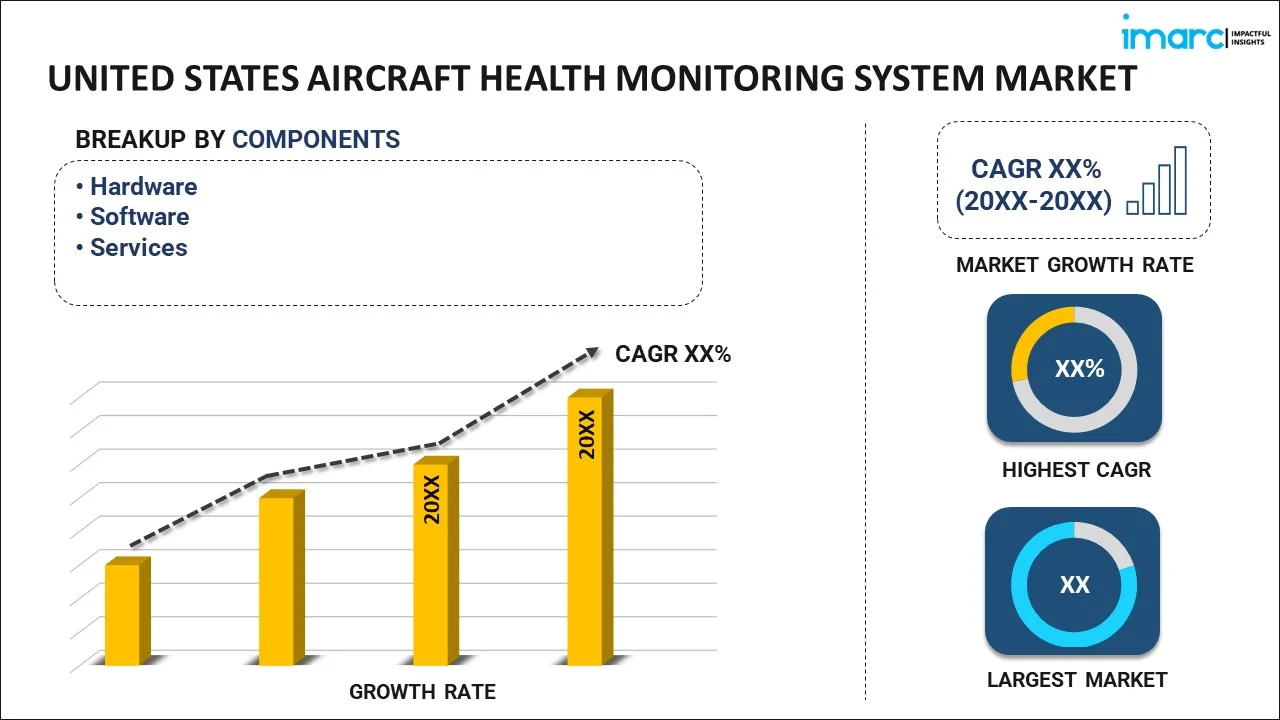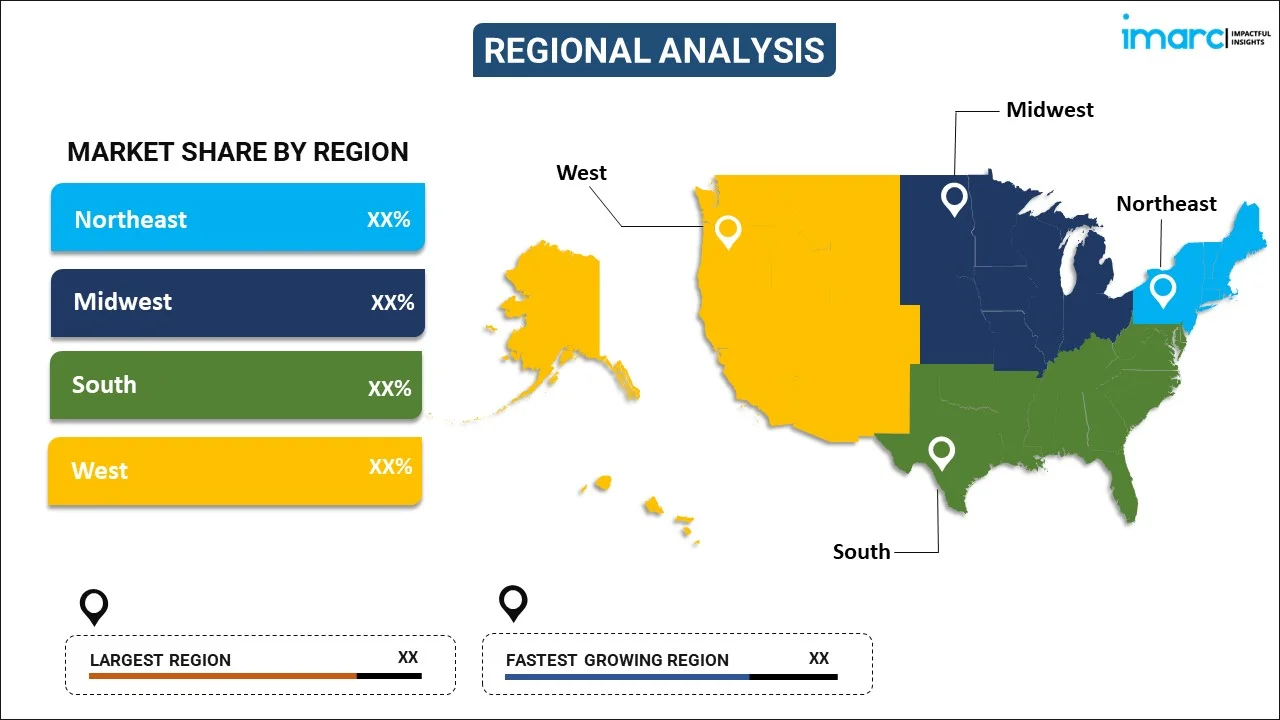
United States Aircraft Health Monitoring System Market Report by Component (Hardware, Software, Services), Subsystem (Aero-Propulsion, Avionics, Ancillary Systems, Aircraft Structures, and Others), End User (Commercial, Military), Installation (Onboard, On Ground), Fit (Linefit, Retrofit), Operation Time (Real-Time, Non-Real-Time), Operation Type (Detection, Diagnostics, Condition-Based Maintenance and Adaptive Control, and Others), and Region 2025-2033
Market Overview:
The United States aircraft health monitoring system market size reached USD 1.8 Billion in 2024. Looking forward, IMARC Group expects the market to reach USD 3.7 Billion by 2033, exhibiting a growth rate (CAGR) of 8.29% during 2025-2033.
|
Report Attribute
|
Key Statistics
|
|---|---|
|
Base Year
|
2024
|
|
Forecast Years
|
2025-2033
|
|
Historical Years
|
2019-2024
|
|
Market Size in 2024
|
USD 1.8 Billion |
|
Market Forecast in 2033
|
USD 3.7 Billion |
| Market Growth Rate 2025-2033 | 8.29% |
Aircraft health monitoring system (AHMS) is a collection of solutions and techniques that are employed to monitor airplane data remotely. It is primarily used for monitoring the lifecycle of aircraft components. It also helps in predicting the failures and malfunctions in an aircraft, such as over-heating engines, high vibrations, low oil pressure and hard landing. The system uses real-time data, which is recorded through different sensors installed on the aircraft and involves automated engine trend reporting, remote systems diagnostics, and engine/airframe threshold exceedance reporting.
The United States aircraft health monitoring system market is primarily driven by the efficient air transportation system. The United States has the largest single national economy and is leading in various industries such as transportation, information technology (IT) and defense aviation industries. The AHMS technology helps minimize the overall maintenance while reducing the operational costs and detection, diagnosis, prognosis, and mitigation of system failure in aircraft components, which is propelling the growth of the market. Besides this, the increasing profitability of airlines, along with the rising demand for IT solutions, like AHMS, are providing a significant impact on the market growth.
Key Market Segmentation:
IMARC Group provides an analysis of the key trends in each sub-segment of the United States aircraft health monitoring system market report, along with forecasts at the country and regional level from 2025-2033. Our report has categorized the market based on component, subsystem, end user, installation, fit, operation time and operation type.
Breakup by Component:

- Hardware
- Software
- Services
Breakup by Subsystem:
- Aero-Propulsion
- Avionics
- Ancillary Systems
- Aircraft Structures
- Others
Breakup by End User:
- Commercial
- Military
Breakup by Installation:
- Onboard
- On Ground
Breakup by Fit:
- Linefit
- Retrofit
Breakup by Operation Time:
- Real-Time
- Non-Real-Time
Breakup by Operation Type:
- Detection
- Diagnostics
- Condition-Based Maintenance and Adaptive Control
- Others
Breakup by Region:

- Northeast
- Midwest
- South
- West
Competitive Landscape:
The competitive landscape of the industry has also been examined along with the profiles of the key players.
Report Coverage:
| Report Features | Details |
|---|---|
| Base Year of the Analysis | 2024 |
| Historical Period | 2019-2024 |
| Forecast Period | 2025-2033 |
| Units | Billion USD |
| Components Covered | Hardware, Software, Services |
| Subsystems Covered | Aero-Propulsion, Avionics, Ancillary Systems, Aircraft Structures, Others |
| End Users Covered | Commercial, Military |
| Installations Covered | Onboard, On Ground |
| Fits Covered | Linefit, Retrofit |
| Operation Times Covered | Real-Time, Non-Real-Time |
| Operation Types Covered | Detection, Diagnostics, Condition-Based Maintenance and Adaptive Control, Others |
| Regions Covered | Northeast, Midwest, South, West |
| Customization Scope | 10% Free Customization |
| Post-Sale Analyst Support | 10-12 Weeks |
| Delivery Format | PDF and Excel through Email (We can also provide the editable version of the report in PPT/Word format on special request) |
Key Questions Answered in This Report
The United States aircraft health monitoring system market was valued at USD 1.8 Billion in 2024.
We expect the United States aircraft health monitoring system market to exhibit a CAGR of 8.29% during 2025-2033.
The rising utilization of aircraft health monitoring systems for monitoring the lifecycle of aircraft components and predicting failures or malfunctions, such as over-heating of engines, high vibrations, low oil pressure, etc., is primarily driving the United States aircraft health monitoring system market.
The sudden outbreak of the COVID-19 pandemic had led to the implementation of stringent lockdown regulations across the nation, resulting in the decline of various aviation activities, thereby negatively impacting the United States market for aircraft health monitoring systems.
Based on the component, the United States aircraft health monitoring system market can be segregated into hardware, software, and services. Currently, hardware exhibits a clear dominance in the market.
Based on the subsystem, the United States aircraft health monitoring system market has been bifurcated into aero-propulsion, avionics, ancillary systems, aircraft structures, and others. Among these, aero-propulsion accounts for the majority of the total market share.
Based on the end user, the United States aircraft health monitoring system market can be segmented into commercial and military. Currently, commercial holds the largest market share.
Based on the installation, the United States aircraft health monitoring system market has been divided into onboard and on ground, where on ground currently exhibits a clear dominance in the market.
Based on the fit, the United States aircraft health monitoring system market can be categorized into linefit and retrofit. Currently, linefit accounts for the majority of the total market share.
Based on the operation time, the United States aircraft health monitoring system market has been segregated into real-time and non-real-time, where real-time currently exhibits a clear dominance in the market.
Based on the operation type, the United States aircraft health monitoring system market can be bifurcated into detection, diagnostics, condition-based maintenance and adaptive control, and others. Currently, detection holds the largest market share.
On a regional level, the market has been classified into Northeast, Midwest, South, and West, where Midwest currently dominates the United States aircraft health monitoring system market.
Need more help?
- Speak to our experienced analysts for insights on the current market scenarios.
- Include additional segments and countries to customize the report as per your requirement.
- Gain an unparalleled competitive advantage in your domain by understanding how to utilize the report and positively impacting your operations and revenue.
- For further assistance, please connect with our analysts.
 Inquire Before Buying
Inquire Before Buying
 Speak to an Analyst
Speak to an Analyst
 Request Brochure
Request Brochure
 Request Customization
Request Customization




.webp)




.webp)












